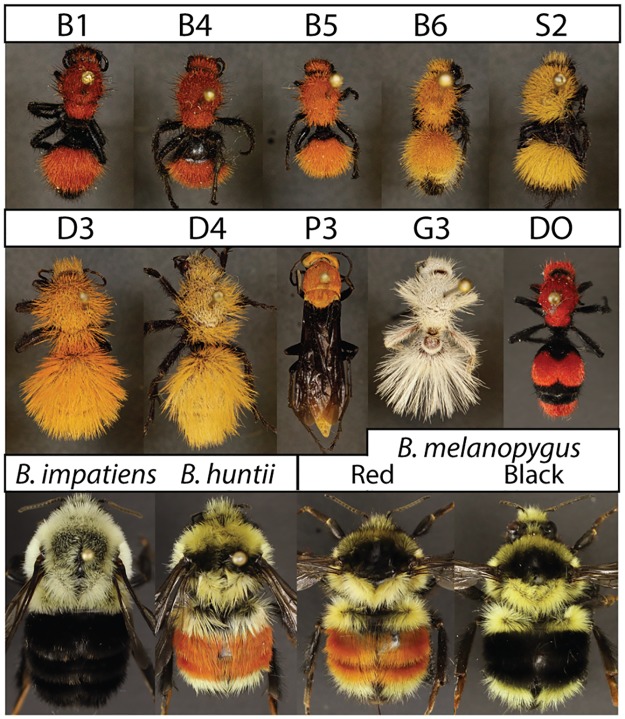Fig 1. Specimens studied.
B1—P3 were used for reflectance and absorbance measurements and represent: B1 = Dasymutilla bioculata, dark orange/red form [USA: Utah: Cache Co., Hyrum; 41.63, 111.86; 7/8/05;T. Bond]; B4 = Dasymutilla bioculata, dark orange/red form [USA: Utah: Cache Co., Hyrum; 41.63, 111.86; 8/11/05; T. Bond]; B5 = Dasymutilla bioculata, medium orange form [USA:Utah: Emery Co., 25km NNE Hanksville, Gilson Butte Well; 38.58, -110.58; 24.VII.2001; M. Hauser]; B6 = Dasymutilla bioculata, light orange form [USA: Utah; Garfield Co.; 37.34, -111.06; 25-July-2001; RW Baumann, RD Gordon, IS Winkler]; S2 = Dasymutilla scitula [USA: Utah; Garfield Co., Calf Creek; 37.83, -111.42; VII-30-1982; Griswold/Parkers]; G3 = Dasymutilla gloriosa [USA: Utah; Washington Co., Werner Valley, 8mi SE St. George, 37.02533, -113.43408; 25-30.viii.2010; J. Wilson]; D3 = Dasymutilla satanas, orange form [USA: Nevada; Rock Valley, Nye Co.; 36.63, -116.31; 7/28/1965; EF Dailey-Attrop]; D4 = Dasymutilla satanas, light orange form [USA: Arizona, Parker Dam; 34.30, -114.13; 7-IX-1963]; P3 = Psorthaspis portiae [USA: Arizona; Cochise Co., Rte. 666 W. of Wilcox; 32.15, -109.93; 17-July-1991; BP Harris]. Remaining specimens are representatives of species used for degradation analysis as well as absorbance and reflectance measurements. DO = Dasymutilla occidentalis. All specimens used were female. Specimens were cropped from their original image. DO and the bumble bees were photographed separately from other mutillids and color was standardized between images. Their scaling relative to other specimens is approximate. Specimens in the first row + G3 were increased to 125% of the scale of other specimens to improve visualization.

